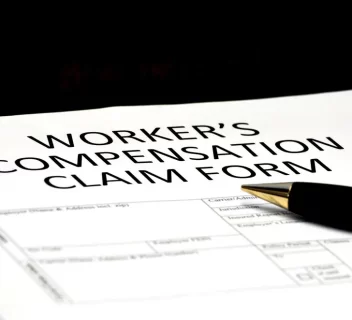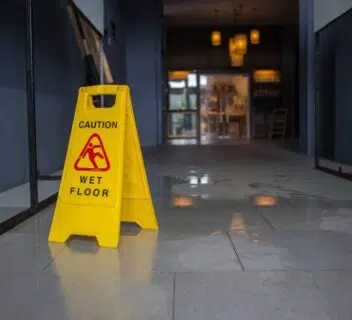What to Do When Injured on the Job: Essential Steps for Employees
If you’ve been injured on the job, knowing what to do when injured on the job is crucial. Prioritize your safety by seeking medical attention and reporting the injury to your employer without delay. Understand that documenting the incident and ensuring timely communication can have a significant impact on your workers’ compensation claim. This article will guide you through every necessary step, from initial actions to filing a claim and understanding your benefits.
Key Takeaways
- Immediately seek medical attention, report the injury to your employer, and document the incident to secure your rights and facilitate the workers’ compensation claim process.
- Filing a workers’ compensation claim should begin promptly, including obtaining the necessary claim forms, documenting injury specifics, and submitting the form to the employer for further processing.
- Understanding the types of workers’ compensation benefits—medical, disability, rehabilitation, and death benefits—is crucial for employees to ensure they receive the appropriate coverage and support during recovery.
Immediate Actions After a Workplace Injury
Workplace injuries can happen in the blink of an eye. Knowing the immediate steps to take can make a world of difference in ensuring your safety and securing your rights when thinking about what to do when injured on the job. Ensuring the affected employee receives immediate medical attention is the top priority.
Next, promptly notify the employer about the incident and meticulously document the details.
Seek Medical Attention
What to do when injured on the job – After being injured on the job, follow these steps:
- Seek medical attention immediately.
- If the injury is severe or requires urgent care, seek emergency medical assistance immediately.
- Inform your healthcare provider that the injury occurred at work to ensure proper documentation and care.
- If you are injured at work, obtain necessary medical treatment or first aid promptly.
In non-emergency situations, the Workers’ Compensation Board must authorize the medical provider taking care of an injury.
Report the Injury to Your Employer
Timely reporting of injuries is crucial as delays can undermine a workers’ compensation claim. Provide detailed information about the incident, including the time, location, and nature of the injury. Reporting the injury to your employer should occur as soon as possible, ideally on the same day.
To retain your rights to workers’ compensation benefits, follow these steps:
- Report the accident in writing within 30 days.
- Ensure that the supervisor prepares a company accident report.
- If the supervisor refuses to prepare the report, write a letter stating the facts.
- Give a copy of the letter to the supervisor.
Document the Incident
Thoroughly document the incident immediately after it occurs. Record details of the incident, including:
- The time
- The location
- Involved parties
- Witness statements
- Photographs
Detailed documentation helps insurance companies process claims more quickly and ensures you receive appropriate care.
Request and keep a copy of the employer’s accident report, as it serves as an official record of the incident. This documentation is crucial for filing an injury claim or resolving any disputes related to the incident.
Filing a Workers’ Compensation Claim
Filing a workers’ compensation claim is the next critical step after immediate actions are taken when considering what to do when injured on the job. This process should begin immediately after the injury, ideally the same day or within a few days, and should be filed as soon as possible.
Workers may need to create an account on a designated online portal and use specific forms related to their injury type to file a claim. Follow the steps methodically to ensure your claim is processed correctly and promptly.
Obtain and Complete the Claim Form
The first step in the claims process is obtaining and completing the workers’ compensation claim form. If your employer does not provide the workers’ comp claim form, you can often obtain it directly from workers’ compensation boards or online resources. Request the claim form from your employer to properly initiate your workers’ compensation claim process.
The form requires details such as injury specifics, the cause of the injury, and your desired action. Complete the form accurately and provide any requested documentation to facilitate processing. Delays in filing an injury report could result in losing your workers’ compensation benefits.
Submit the Claim Form
Submit the completed claim form to your employer to initiate the workers’ compensation process. Verify that your employer has sent the Employer’s First Report of Injury form to the insurer.
Keep a copy of the claim form for your personal records to ensure you have documentation of your claim. This step is crucial for tracking the status of your injury claim and ensuring all necessary information is accurately reported.
Follow Up on the Claim
To manage your workers’ compensation claim effectively:
- Regularly follow up on your claim to ensure it is processed without unnecessary delays.
- Regularly check in with the insurer.
- Inform both your employer and the insurance company about any changes in your condition.
Keep comprehensive records of all related paperwork and accurate documentation of medical treatments and communications to support your claim. This proactive approach can help prevent delays and ensure fair compensation.
Understanding Workers’ Compensation Benefits
Comprehending the benefits you are entitled to under workers’ compensation is vital. Workers’ compensation encompasses four primary types of workers’ comp benefits:
- Medical
- Disability
- Rehabilitation
- Death benefits
These benefits can provide coverage for medical expenses, lost wages, and related costs.
Familiarizing yourself with the specifics of each type of benefit can help you maximize the support you receive during your recovery.
Medical Benefits
Medical benefits under workers’ compensation cover a wide range of medical expenses, including hospital stays, physical therapy, and necessary medical equipment. Employers have the ability to designate medical providers for work-related injuries, which can impact the choice of healthcare for injured workers.
Grasping these medical care benefits ensures you receive necessary care without a financial burden, especially when consulting a doctor.
Disability Benefits
Disability benefits are classified into four categories:
- Temporary total
- Temporary partial
- Permanent total
- Permanent partial disabilities
These benefits cover employees for lost wages while recovering from work-related illnesses and injuries. The benefit amount is typically two-thirds of an employee’s weekly wage.
Identifying the type of disability benefits you qualify for can assist in planning your recovery and financial stability.
Death Benefits
In the unfortunate event of a worker’s death due to a workplace injury, dependents are entitled to death benefits. These benefits cover funeral expenses and typically amount to two-thirds of the worker’s average weekly wage.
These benefits can provide financial relief to the family of the deceased worker during a difficult time.
Legal Rights and Protections for Injured Workers
Various legal rights and protections exist to ensure injured workers receive the support they need. Employers are required to support the recovery of the injured worker by maintaining communication with the employee, medical providers, and insurance carriers.
Most states mandate businesses to carry workers’ compensation insurance to protect employees from the financial burden of workplace injuries.
Right to Fair Treatment
Employees are entitled to compensation for injury-related costs through their employer’s insurance. Covered medical services under workers’ compensation and workers’ comp are the responsibility of the employer’s workers’ compensation insurance carrier or self-insured employer.
Workers are entitled to pursue their claims without facing intimidation or threats from their employer. Clear communication and cooperation with medical providers are essential for an injured employee’s return to work.
When to Consult a Lawyer
Seek legal advice if your employer complicates your ability to claim workers’ compensation. Injured workers should seek legal help if their claims are denied, as attorneys can assist with appeals.
Consult a lawyer if circumstances may allow for a workers’ compensation claim or other legal action. Having an attorney when dealing with insurance companies provides equal protection against the attorneys that insurance companies have.
Contact 1-800-THE-LAW2 today for a free consultation with a workers’ compensation lawyer in our professional network.
Preventing Future Workplace Injuries
Prevention is always better than a cure. Effective safety protocols and ongoing employee training can significantly reduce the occurrence of workplace injuries. Continuous education on safety measures enhances overall safety standards among employees.
Reviewing Safety Protocols
Regularly reviewing safety protocols maintains a safe workplace. Effective safety protocols should include:
- Clear guidelines
- Procedures
- Compliance measures: Training employees on safety procedures ensures everyone is aware of best practices and safety measures.
Regular equipment inspections are crucial to prevent accidents and ensure workplace safety.
Employee Training
Continuous employee training is vital to maintaining occupational safety standards and reducing workplace injuries. Employees should undergo regular training on safety practices, including emergency procedures and hazard recognition. Training on proper equipment use ensures that employees know how to operate machinery safely and effectively.
Ongoing training is necessary to adapt to new safety standards as workplace practices and technologies evolve.
Reporting Hazards
Regular inspections and updates of safety protocols help identify potential risks and ensure compliance with safety standards. Key practices include:
- Conducting regular assessments of safety protocols
- Performing assessments, especially after any incidents
- Reviewing protocols following significant operational changes
Encouraging prompt hazard reporting aids in timely interventions and maintaining workplace safety.
Navigating the Workers’ Compensation System
Clear communication and meticulous record-keeping can ease the daunting process of navigating the workers’ compensation system. Informing healthcare providers that the injury is work-related facilitates proper documentation.
Accurate record-keeping and communicating any changes in your medical condition to your employer and the insurance company are crucial.
Communicating with Medical Providers
Effective communication with medical providers ensures that injured workers receive appropriate care for their work-related injuries. Adhering to all medical directions during the claim evaluation is vital for recovery and claim support.
Confirm that your employer has sent the necessary injury report to the insurance provider after you submit your claim.
Keeping Detailed Records
Detailed records following a workplace injury ensure that your rights are protected and you receive appropriate benefits. Essential records include:
- Injury reports
- Medical documentation
- Communication logs
- Wage histories
Keep a personal copy of the submitted claim form to track your claim’s status.
Preparing for a Hearing
If dissatisfied with the claim outcome or if the employer disputes the benefit claim, seeking a hearing with the Workers’ Compensation Board is the next step.
Organize documentation that supports your claim and outlines your injury details when preparing for a hearing.
Common Workplace Injuries and Their Causes
Understanding common workplace injuries and their most common causes aids in their prevention. Work-related injuries or illnesses that occur during normal work scope can include:
- Sprains
- Fractures
- Burns
- Repetitive motion injuries.
Workplace injuries commonly include broken bones, soft tissue injuries, and injuries to muscles, tendons, and ligaments.
Repetitive Stress Injuries
Repetitive stress injuries often result from tasks that require repeated motions over time, leading to strain and discomfort. Implementing ergonomic practices and allowing for regular breaks can prevent these injuries.
Slip-and-Fall Accidents
Slip-and-fall accidents are often caused by wet or slippery surfaces, uneven flooring, or obstructions in walkways. Inadequate lighting can also contribute significantly to the likelihood of slip-and-fall incidents.
Regular walkway inspections, prompt cleanup of spills, and installation of non-slip mats can decrease slip-and-fall accidents. Training on safety practices, including proper footwear and hazard recognition, is essential to preventing slip-and-fall incidents.
Equipment-Related Injuries
Equipment-related injuries are a significant cause of workplace accidents, ranking as the third leading cause of work-related deaths. Common types of equipment-related injuries include being struck by falling objects, getting caught in machinery, and being compressed by powered equipment. These injuries often lead to an average of 10 days away from work for affected employees.
Regular maintenance and proper training on equipment use are essential for preventing these injuries.
Summary
Navigating the aftermath of a workplace injury can be complex, but knowing the essential steps can make a significant difference. Immediate actions such as seeking medical attention, reporting the injury to your employer, and documenting the incident lay the groundwork for a successful workers’ compensation claim. Filing the claim promptly and following up ensures you receive the benefits you are entitled to, including medical, disability, and death benefits.
Understanding your legal rights and protections is crucial, and knowing when to consult a lawyer can safeguard your interests. Prevention remains the best strategy, with regular reviews of safety protocols, continuous employee training, and prompt reporting of hazards playing key roles in maintaining a safe workplace. By following these guidelines, injured workers can secure their health, rights, and financial stability, while employers can foster a safer work environment.
Frequently Asked Questions
It is crucial to seek medical attention immediately after a workplace injury, report the incident to your employer, and document everything with detailed information and witness statements. Taking these steps ensures your health and protects your rights.
To file a workers’ compensation claim, obtain the claim form from your employer or the workers’ compensation board, complete it accurately, and submit it to your employer while retaining a copy for your records.
You can receive medical expenses coverage, disability benefits, and death benefits for your dependents if you are a deceased worker. These benefits aim to support you during recovery and provide financial assistance in unfortunate circumstances.
You should consult a lawyer immediately if your workers’ compensation claim is denied, if your employer complicates the process, or if there are disputes regarding your entitled benefits. It is crucial to protect your rights and ensure you receive fair compensation.
To prevent workplace injuries, it is essential to regularly review safety protocols, provide continuous employee training, and encourage prompt reporting of hazards. This proactive approach fosters a safer work environment.




